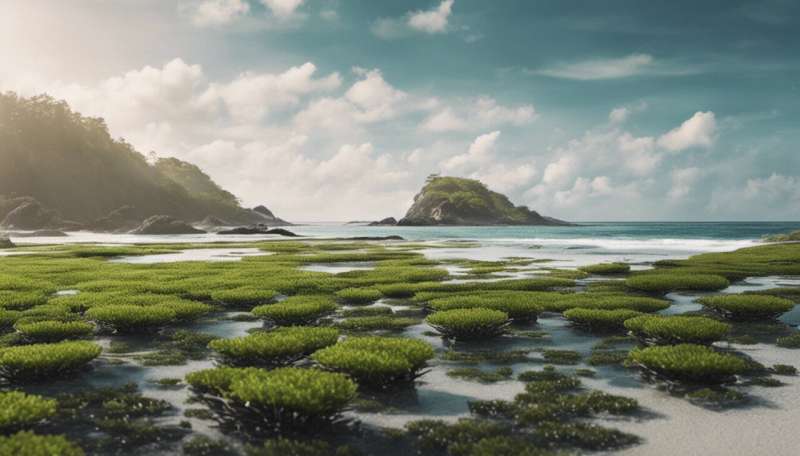
Seagrasses are flowering plants that form dense underwater meadows in coastal waters worldwide, from the frigid seas of the Arctic to the warm shallows of the Caribbean. These meadows provide a refuge for young fish, food for grazing sea turtles and manatees, and help to slow climate change by absorbing carbon from the atmosphere up to 35 times faster than rainforests.
In a new study published in Communications Earth & Environment, we discovered another reason to preserve the world’s remaining seagrass meadows: they can build and maintain coral reef islands.
Throughout the tropics, the breakdown of shells and skeletons belonging to organisms living on coral reefs has produced enough sand to form entire islands. These coral reef islands are inhabited by over 700,000 people globally in nations including Kiribati, the Marshall Islands and the Maldives. Our research showed that seagrass meadows can make the right type of sand for building and maintaining the shorelines of these islands. This sand could help protect them from sea-level rise, which threatens the existence of low-lying nations.
Islands in the Maldives are primarily built from coral, but rising sea temperatures have caused reefs to bleach in recent years, which can kill corals. Seagrass may be vital for building and maintaining these islands in the future if reefs are lost to climate change.
How seagrass builds islands
If you are ever lucky enough to swim in a tropical seagrass meadow, take a close look at the leaves. You may notice that, instead of being completely smooth and green, there are what look like white grains of sand stuck to their surface.
A microscope reveals that these white grains are in fact tiny plants and animals. These creatures—scientists call them seagrass epibionts—are made of calcium carbonate and can include sea snails, single-celled foraminifera, crusts of coralline algae and colonies of invertebrates called bryozoans.
Some epibionts fall off the leaves or are whisked away when the seagrass dies to be deposited with other sediment on nearby islands. Over time, this accumulation helps to build and maintain the island shorelines. In our study, we aimed to find out how much sand was produced by organisms living in a seagrass meadow in the southern Maldives.
We used satellite images to map the density of seagrass and counted the leaves by randomly placing grids on the seafloor. We repeated this process 300 times, counting 27,528 individual seagrass leaves—not how most visitors to the Maldives spend their trip.
We collected 400 leaves and analyzed them in a laboratory to work out the mass of epibionts living on them. The sand samples we collected from the meadow indicated how many of these organisms were the right size for building an island (between 0.063 and 2mm).
How much sand does a seagrass meadow make?
The rate at which different parts of the meadow produced sand-sized grains ranged from 0.22 to 0.86kg per square meter per year. Across the 1.1 square kilometers of seagrass meadow we studied, total annual sediment production was 762,000kg, with 482,000kg of this being the right size for island-building.
The volume of sand-sized sediment produced across the meadow would be large enough to build the neighboring island of Faathihutta in just 18 years. Not all of this sand will go on to build islands—some will remain in the ocean. Nonetheless, this is a huge volume of sand being produced near islands in desperate need of sediment to bolster shorelines threatened by rising seas.
Reef island nations will need to protect seagrass meadows and aid their recovery in areas where they have been damaged. Another challenge will be ensuring that the movement of sand from seagrass meadows to islands is not obstructed by sea walls, harbors or jetties.
The societal benefits of seagrass meadows remain underappreciated. In the Maldives, seagrass is often removed from tourist resorts to meet visitor expectations of pristine white sands. This is a misconception of what the shallow waters around tropical islands are supposed to look like—and one that deprives visitors of the wide variety of marine life that call seagrass meadows home, such as schools of baby fish, seahorses and turtles.
Tourists should now also be aware that the very survival of the coral reef islands may depend on the sand that these seagrass meadows produce.
More information:
Holly K. East et al, Seagrass meadows are important sources of reef island-building sediment, Communications Earth & Environment (2023). DOI: 10.1038/s43247-023-00675-y
Provided by
The Conversation
This article is republished from The Conversation under a Creative Commons license. Read the original article.
Tropical seagrass meadows are sand factories that could protect coral reef islands from sea-level rise (2023, February 17)
retrieved 18 February 2023
from https://phys.org/news/2023-02-tropical-seagrass-meadows-sand-factories.html
part may be reproduced without the written permission. The content is provided for information purposes only.